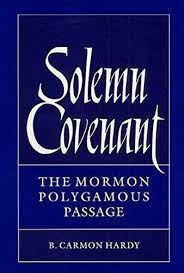Articles/Essays – Volume 26, No. 2
“In Obedience There Is Peace and Joy Unspotted” | B. Carmon Hardy, Solemn Covenant: The Mormon Polygamous Passage
The prophet Joseph Smith once told Nancy Rigdon, whom he was attempting to persuade to become his plural wife, that whatever God required was right, no matter what it was (374). Smith went on to observe that “in obedience there is joy and peace unspotted.” B. Carmon Hardy has painstakingly re searched and skillfully brought to life the stories of many nineteenth-century Latter-day Saints who attempted to obey the most widely known aspect of Mormon domestic life—polygamy.
Through his plumbing of LDS church archives, family group sheets at Salt Lake City’s Family History Library, and other familiar and not so familiar sources (such as the Record of Members located at the LDS historical Library and the Family History Library), Hardy has managed to compile a sizeable list of known plural marriages. It is post-Manifesto polygamous unions which most interests him. And 70 percent of Solemn Covenant (seven out of ten chapters) focus on this long-subdued aspect of the Mormon past which was rarely spoken or written about until the 1970s and 1980s.
While some readers (including me) may initially require some coaxing to accept Hardy’s view of just how wide spread and important the principle of plurality was among nineteenth-century Mormons, most will become at least partial believers by the end of Solemn Covenant. This turnaround is largely due to soundness of the author’s research and the convincing argument carried by the narrative. He contends, and demonstrates, that plural marriage filled special Mormon needs from its beginnings in Joseph Smith’s lifetime through post Manifesto plurality and up to present day fundamentalism. Polygamy, although never the lifestyle of the Mormon majority, was, in Hardy’s words, “a departure of conspicuous proportions in Western family history” (xviii).
Why most nineteenth-century Latter-day Saints steadfastly defended the principle and how twentieth-century members were almost completely weaned from even wishing to acknowledge that plural marriage had ever existed in their church is what Solemn Covenant is really all about. In an exciting appendix essay aptly entitled “Lying for the Lord,” Hardy lays out the di lemma which post-Manifesto polygamy made incumbent on the Mormon community at large. In early 1907 the First Presidency issued a major address in which it categorically denied any official involvement in post Manifesto plural marriages. Yet according to Hardy’s findings and those of other scholars, such was not the case. As forthright and upstanding as Mormons may have wished to be, Hardy charges that Mormon leaders, from Joseph Smith’s day on, often withheld knowledge concerning polygamy not only from the general public but from many of their own followers. In his charge to leading Saints “do not betray your Friend,” Smith had, according to Hardy, laid down a connection between secrecy and friendship which lasted, at least, until the early twentieth century (366).
And never was the necessity of secrecy more clearly evident than in regard to post-Manifesto polygamy. Internal dissent over the use of mistruth as a defense for the ongoing practice of plural marriage tore the Mormon community asunder from the lowest levels to the highest. Some ecclesiastical leaders, such as George Q. Cannon or John Henry Smith, apparently had no qualms about lying for the Lord. Others, most notably apostles John W. Taylor and Charles W. Penrose, while supporting the continuance of plural marriages, believed such distortions were reprehensible. The Taylor and Penrose stance urging more openness found few contemporary disciples, however. In fact, church president Joseph F. Smith would come to label Penrose “a Judas” (372).
Solemn Covenant deserves to be read widely and discussed within and outside of the Mormon scholarly community. While it is unlikely that all will see polygamy in exactly the same light as does Carmon Hardy, it is very likely that most readers will be forced at least to reevaluate some of their opinions about polygamy. This book will make the thinking reader think further. And that, after all, is the most one can ask from any book.
B. Carmon Hardy. Solemn Covenant: The Mormon Polygamous Passage. Urbana: University of Illinois Press, 1992. 362 pp., notes, illustrations, appendices.


 Back to full Issue
Back to full Issue

